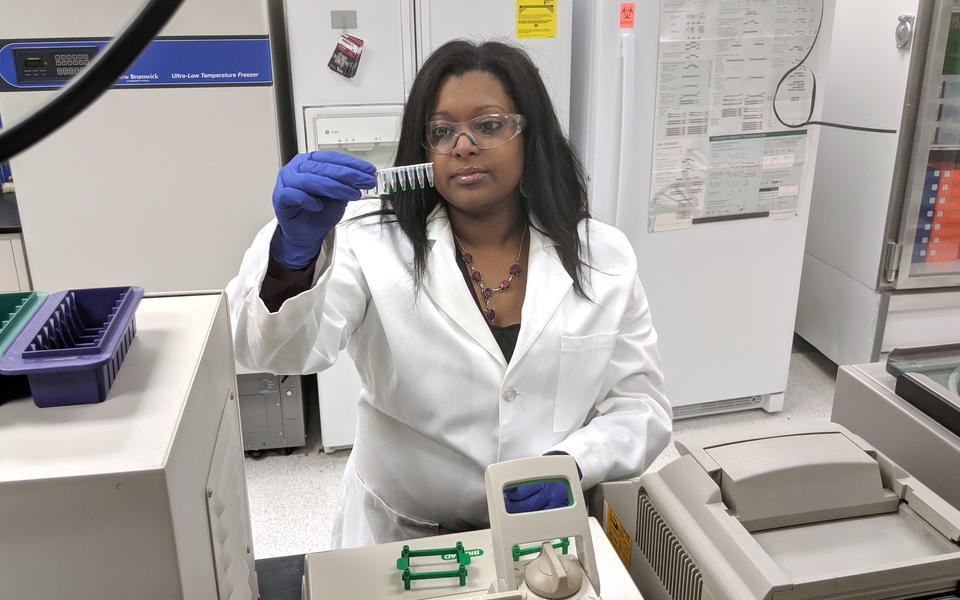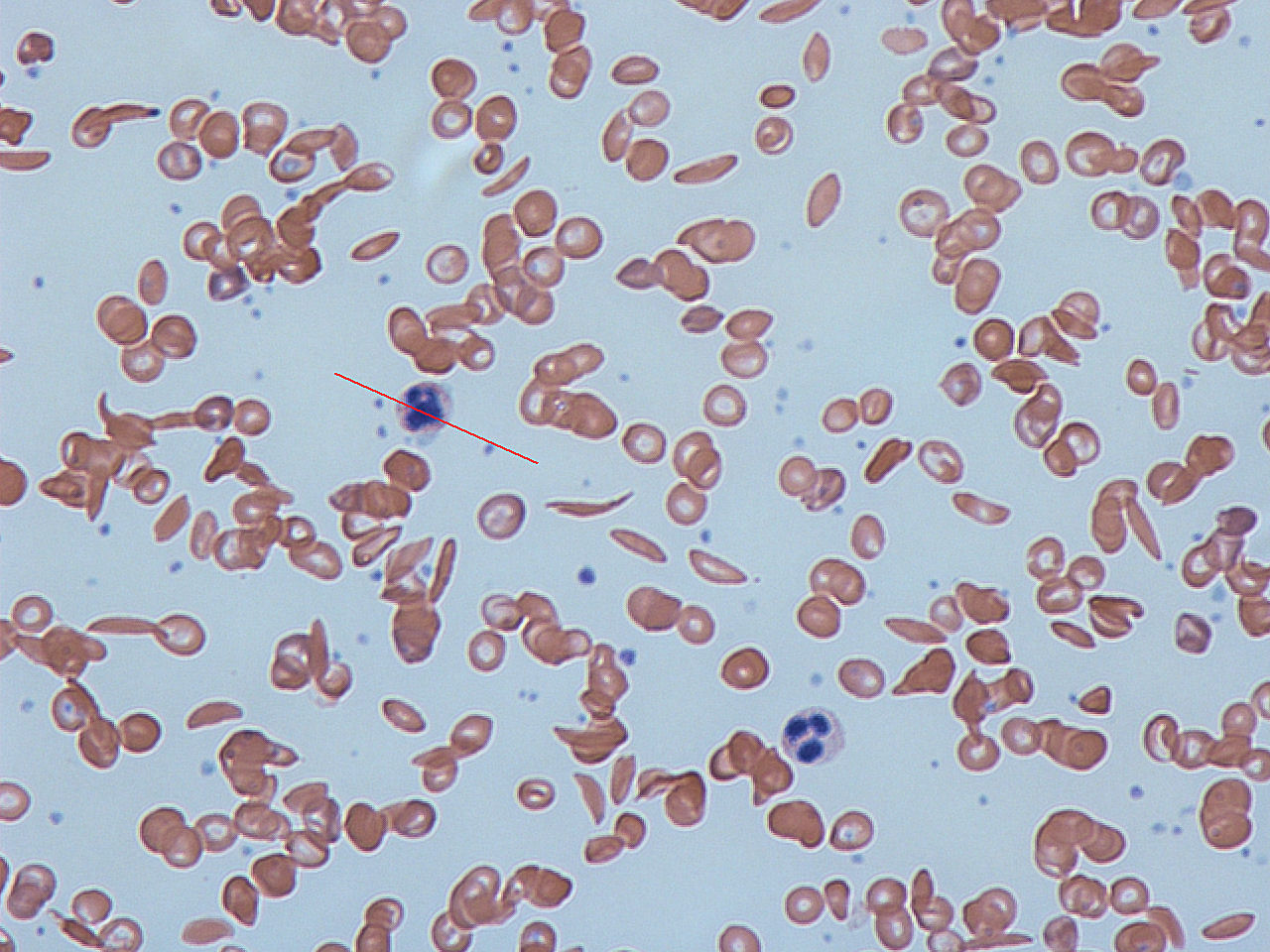Taking Measure
Just a Standard Blog

Genome Editing Program leader Samantha Maragh inspects vials of genetic material.
I didn’t understand what people were asking me when I was a kid. The question would come in several different forms. Sometimes it was “What are you?” Other times it was “Where are you from?” I would answer with things I knew to be true, like “I’m a girl” or “I’m a person” or “I’m from Maryland,” in a sincere, but failed, effort to satisfy my questioner.
I later came to understand that these people actually wanted to know my ethnicity. I grew up in a stereotypical melting pot USA kind of place, otherwise known as Howard County, Maryland, where many neighbors and classmates were of various ethnic backgrounds. Even in this melting pot, I was different. I am of mixed ethnicity: My mom’s half is Afro-Caribbean by way of Jamaica, and my dad’s half is East Indian by way of the West Indies. I couldn’t be placed in one bin, and I was keenly aware from the questions I received that I was different. This made me want to understand this “otherness,” and that is what sparked my love of human genetics.
Now that you know a bit about me and I’ve got you thinking, I want to tell you about some of the exciting things that keep my love of human genetics going strong. We are living in the genome era, in which we have the technology to “read” the four letters (A, C, T and G) of our DNA, the blueprint of life that is unique to each person and resides in every cell of our bodies. The genome is the entire complement of an organism’s genetic code, some 6.6 billion letters of DNA for humans. With DNA tests for disease diagnosis and treatment options, paternity, ancestry and criminal justice, the genome has become part of our culture.
The ability to efficiently read the genome has accelerated technology and medicine and given us access to life-changing knowledge, but there is a revolution underway: rewriting or “editing” the DNA of existing genomes. This groundbreaking field uses programmable tools such as CRISPR/Cas9 to target a specific sequence within a genome and permanently alter the genetic code.
Genome editing is being pursued globally by governments, academics, and the private sector to enable advances in how genetics may impact disease, therapies for diseases such as cancer, new types of antimicrobials and antivirals, and food production. One exciting application being pursued is called gene therapy. Here, problematic DNA causing or contributing to disease is edited so that it no longer causes harm. In some human diseases, as little as a single incorrect letter at a specific position can cause a serious, and potentially deadly, condition (e.g., sickle cell disease). Now, genome editing promises an era in which medicine isn’t limited to solely managing symptoms and treating episodes of this illnesses but could be used to engineer the cells of a patient to “fix” their disease at the genetic level. Those in the biomedical field are daring to think and even speak the word “cure” for so many people who had few or no options previously.

In addition, the agriculture industry has begun editing crop genomes to have more favorable traits such as better yields and disease and drought resistance. The idea here is that instead of conventional plant breeding that may take years to get a single plant with all the desired characteristics and without the undesired ones, genome editing can directly change the DNA of a single plant to have all those traits, accelerating this process by months or years.
These are indeed exciting times! But where there is great promise there is a duty to be careful and cautious with how we proceed and ask, not only if we can do something, but how well are we doing it and should we be doing it at all?
Let’s return to the marvel of a single letter of the approximately 6.6 billion letters of human DNA being the cause of disease and the possibility that that one disease-causing letter could be fixed with genome editing. If this approach was taken to edit this disease-causing letter, we need to stop and ask if we edited the letter we intended. We need to know if we made a T a C when we meant to make it an A. We need to know if we have changed any other single letters or sequences of letters at other unintended locations within the genome. If so, does it matter? The answer to all these questions is sometimes yes, sometimes no or maybe! They all hinge on the quality of the measurements. If the right thing or the wrong thing had occurred, could you detect it?
The challenge of how to know that we know about what and where we’ve edited a genome is being faced head-on by the NIST Genome Editing Consortium. This consortium brings together experts across different sectors including government, academia, non-profit organizations and industry to develop standards and controls to increase the confidence of using genome editing to alter cells. This NIST consortium is working to develop standards and genome editing community norms for physical DNA measurements, and data handling and housing, as well as standard definitions of key terms for the genome-editing field. One project involves developing physical control samples that have characteristics of edited DNA or are indeed edited DNA, which researchers can use to understand their DNA measurements and give confidence to the wider scientific community or product regulators that the measurements used are sound.
(In fact, we are asking for feedback from the public right now on our draft standard definitions for genome editing terms. Check it out!)
We are just at the beginning of this revolution, and there are many technical and ethical questions still to answer. In which situations should genome editing be pursued? When is it acceptable to make permanent changes to cells and provide them as tools or therapies, or introduce altered organisms into nature? Should we edit human DNA in a way that those changes are passed on to the next generation? Should we be allowed to edit human DNA to not only cure disease, but also prevent disease that someone is predisposed to, or even further, enhance humans by making them taller, smarter or stronger? Thus far there is a consensus among experts worldwide that editing human embryos or enhancing people is not acceptable at this time, but there are still those who want to try.
NIST isn’t going to weigh in on any of the ethical debates. That’s not our place. But we will be there to support quality and confidence in the measurements and data underpinning this technology.
While there are many things that need careful consideration, genome editing holds incredible promise and possibility. And remember, just because edited cells are different and “other” doesn’t diminish their potential value.
About the author
Related Posts
Comments
In a nutshell, I read this article to be saying: " sure, there are ethical questions, but we are going to do it anyway". The problem I see most grave:plagiarism. The presumption of ownership of one's own genome is outrageous. Not one human being can stand forth and truthfully claim to have written their own genome. The copyright of any DNA obviously generates from outside the human experience. And since their is already an outstanding claim against all DNA, globally published and in writing; to breach the genome is plagiarism. Or, are you not aware of the most highly distributed written document in existence that lays claim to the human genome: the Bible? After all, unmistakeably, it begins with the word genes: GENES(is). And the Bible emphatically states: HANDS OFF!
Hi Len,
I actually read this article’s sections on ethics a bit differently. My understanding of Dr. Maragh’s statements is that the ethical questions are important to ask and get the proper answers to before proceeding with any genetic manipulations on humans; however, answering ethical questions isn’t NIST’s particular jurisdiction as the National Institute of Standards, which is essentially the Quality Assurance department for scientific processes. NIST’s job is to ensure – IF scientific, legal, and popular communities discern that genome editing is acceptable in any capacity, and IF patients then request the treatment – that the procedures are done properly, in a precise and standardized fashion, in order to prevent problems and protect people. That seems to indicate an excess of concern for people’s welfare given that the procedures haven’t even been approved yet, and loving and serving people – especially those in need – is the very nature of the Law of Christ (Matt. 2:37-40, Rom. 13:8-10, Gal. 6:2).
I, too, believe in the Biblical ethic and worldview. Interestingly, I also happen to know several committed, bible-believing Christians who are working in the field of genome editing. I would take your statement that none of us owns his or her genome and actually extend it to the entire body and spirit. God has created (and thereby copyrighted) these things, yet He has also charged us with stewarding them well, toward health and wholeness despite the realities of inevitable physical decay. We have both the right and obligation to honor what God has entrusted to us (1 Cor.6:19-20, 1 Tim. 4:8), and taking care of our bodies is assumed as standard procedure (Eph. 5:29).
Our present world is very different from the way God created and desired it to be. What He originally called “very good” (Gen. 1:31) entered bondage to decay and death (Rom. 8:19-22) as a result of the Fall (Gen. 3:17-19), and that decay was compounded due to the environmental changes after the Flood, when life spans were cut in half (Gen. 9:29, cf. Gen. 11:10-17), and as a consequence for the Tower of Babel, when life spans were halved again after Pangaea was split (Gen. 11:18-25, cf. Gen. 10:25, 11:8-9). The world we live in is broken in every respect as a consequence of sin – our heart (loves/values), soul (desires), mind (thinking) and strength (body) – yet we’re called to fight against the brokenness around and within us, to do the best we can with what we have, for the sake of ourselves, our neighbors, and the Name of Christ Himself (Rom. 12:1-2). God not only healed people physically through Christ and the prophets, apostles and those with the gift of healing, but put responsibility on each person to protect, preserve, and heal ourselves physically (Prov. 3:7-8, Prov. 4:22, etc.). Giving natural effort to healing others physically, even by simply cleaning and bandaging wounds, is called “mercy” or “compassion” in Scripture, which is both commended and commanded as an application of the Law of Christ, to love others as ourselves (Eccl. 3:3, Zech. 7:9, Luke 10:25-37). I think we also need to be open to the possibility that the Spirit may give healing skills to some doctors as perhaps He gave them to the physician Luke, and as He has given various other skills to His servants to accomplish what He desired in the world (Ex. 31:1-11).
In light of the fact that the intention for this procedure is gene therapy, I see it simply as another mode of healing, as an act of love, mercy and compassion toward those in need – people such as Lupe, who commented hours before you did, to convey great longing and excitement about the potential to heal their longstanding conditions. Who knows? Perhaps this is exactly what Jesus did to heal the invalid at the Pool of Bethesda (John 5:2-9), the man born blind (John 9:1-32), the woman with the issue of blood (Luke 8:43-48), and the woman who was an invalid for 18 years (Luke 13:11-16) – who Jesus described not as created by God to be that way, but later afflicted by someone else to become that way – and we’re called to follow Christ’s example in loving others in all things (John 13:15, Eph. 4:15-16, etc.). NIST just wants to make sure this procedure is safe and have a standard to hold the scientific and medical communities accountable to so it will be an instrument of pure love toward people if it’s ever implemented.
A really interesting article - it had me hooked from beginning to end. Thanks to Dr Samantha Maragh for sharing her insight into this fascinating part of genome science :]
Kind regards.
Kerry Ballard
It all sounds good and could be coming from the right place now, but in the wrong hands it could end man kind as we know it. We all know where the world is today and those who are running it, the question is " do you trust those who are running the world right now to do the right thing with this type of information? These people aren't even for God's ways at all. Messing with things in the human body that can alter one's own DNA is a very scary place to go I myself believe. Because there will always be the evil side, why give them the tools that could portenionly harm man kind & God's will???






This is very exciting especially from someone who’s family has issues with a wide variety of AI diseases from two defective genes that were inherited from my grandfather. I can already see the potential this new field can produce.